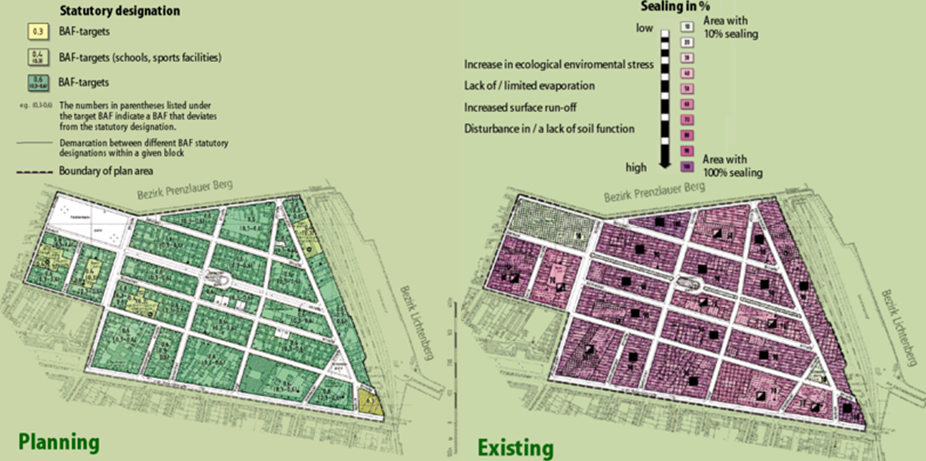The Biotope Area Factor establishes that the development of new buildings requires a proportion of the area to be left as a green space. The BAF provides developers, architects and designers with clear but flexible guidelines on the portion of the plot of land that must be planted or provide other green space functions in terms of: improvement of the microclimate, urban cooling, sustainable drainage, improvement of natural habitats and enhancement of the quality of the residential environment. Specific solutions implemented in the BAF include: (i) greening of functional spaces (e.g. bike or bin sheds); (ii) planting trees and shrubs or, in smaller areas, climbing plants to create green walls; (iii) introducing green roofs; (iv) paving restricted to main routes and use of permeable surfaces elsewhere.
These measures reduce radiation fluxes, provide shade, provide a cooling effect inside buildings and outside, improve air and water quality, and improve the proper management of storm-water run-off. The strength of the BAF concept is that it allows flexibility of the site design: the developer may decide what green space measures are applied, and where, as long as the required green space ratio is achieved.
The BAF formula calculates the proportion of an area that needs to be green space: BAF = Ecologically Effective Surface Areas/Total Land Area. BAF targets depend on the specific uses of an area. The Ecologically Effective Surface Areas is a weighted sum of the areas belonging to the different categories foreseen in the measure, where weighting factors capture the different “ecological values” of these categories. Different types of green spaces are weighted differently according to these “ecological value”, which are based on evapotranspiration capacity, permeability, possibility to store rainwater, relationship to soil functioning and provision of habitat for plants and animals. For example, the weighting factor of a sealed asphalt surface is 0; that of extensive green roofs is 0.5; that of surfaces with vegetation connected to soil below is 1. Residential and public areas need to achieve a BAF target of 0.6 while commercial, business and administrative areas are requested to achieve a lower target of 0.3.
Since December 2019, the prescribed weighting factors for vertical greenery and roof greening has undergone the following refinements: vertical greenery without connection to the ground: 0.7 per m2; extensive roof greening: 0.5 per m2; semi-intensive roof greening: 0.7 per m2; intensive roof greening: 0.8 per m2. The developers can thus use a wide range of options combining different areas with different types of surfaces for achieving the required standard.



